Serviços Personalizados
Journal
Artigo
Indicadores
Links relacionados
Compartilhar
Portugaliae Electrochimica Acta
versão impressa ISSN 0872-1904
Port. Electrochim. Acta vol.30 no.2 Coimbra mar. 2012
https://doi.org/10.4152/pea.201202081
Na+ Ion Conducting Hot-pressed Nano Composite Polymer Electrolytes
Angesh Chandra1,*, Archan Chandra1 and Kiran Thakurb2
1 Department of Applied Physics, Shri Shankaracharya Institute of Professional Management & Technology, Raipur - 492015, C. G., India
2 Department of Applied Chemistry, Raipur Institute of Technology, Raipur-492101, C.G., India
doi: 10.4152/pea.201202081
Abstract
Synthesis, characterization and polymeric battery studies of Na+ ion conducting Nano- Composite Polymer Electrolyte (NCPE) membranes: (1-x) [75PEO: 25NaPO3]: x SiO2, where x = 0 - 15 wt. (%), has been reported. NCPE membranes have been casted using a novel hot-press technique in place of the traditional solution cast method. The dispersal of SiO2 in SPE host: (75PEO: 25NaPO3), a conductivity enhancement of an order of magnitude achieved in NCPE film: [93 (75PEO: 25NaPO3): 7 SiO2]. This has been referred to as Optimum Conducting Composition (OCC). Material characterizations have been done with the help of XRD, SEM and DSC techniques. The ion transport behaviour in hot-pressed NCPEs has been discussed on the basis of experimental measurements on some basic ionic parameters viz. conductivity (σ), ionic mobility (μ), mobile ion concentration (n) and ionic transference number (tion). The temperature dependent conductivity studies have been done to compute the activation energy (Ea) values from the 'log s - 1/T' Arrhenius plots. The ion conducting solid state polymeric battery was fabricated and cell-potential discharge characteristics have been studied at different load conditions.
Keywords: nano-composite polymer electrolyte, ionic conductivity, X-ray diffraction, differential scanning calorimetry (DSC), polymeric battery.
Introduction
The development of new ion conducting nano-composite polymer electrolytes (NCPEs) is one of the important areas of research in the last 30 years. The NCPEs show tremendous technological potential to develop flexible solid state polymeric batteries over the solid polymer electrolytes (SPEs). The main advantages of NCPEs are their mechanical properties, ease of fabrication of desirable shapes/sizes, and they are also important for improving the proper contact between electrode-electrolyte in polymeric batteries [1-8]. In the recent past, several PEO-based polymer electrolytes have been widely investigated because of their potential application in polymeric batteries. Polymer electrolyte films are formed, in general, via solution-cast and sol-gel routes. However, recently, an alternate hot-press technique has been developed for casting completely dry polymer electrolyte films [7-10]. The sodium salt has several advantages over lithium. Sodium is much more abundant and less expensive over lithium [6, 10, 11]. In the present investigation, the author reported synthesis, characterization and polymeric battery application of Na+ ion conducting hot- pressed nano-composite polymer electrolytes (NCPEs): (1-x) [75 PEO: 25 NaPO3]: x SiO2, where x = 0 - 15 wt. (%). The materials characterization and ion transport studies have been carried out with the help of various experimental techniques. Based on these NCPE, a new solid state polymeric battery has been fabricated and their discharge characteristics are studied under different load conditions.
Experimental
Dry powders of AR grade chemicals: poly (ethylene oxide) PEO (105 MW, Aldrich, USA), NaPO3 (purity > 98%, Merck, India) and SiO2 (> 99.8%, particle size ~ 8 nm, Sigma, USA) have been used for casting of NCPEs: (1-x) [75PEO: 25NaPO3]: x SiO2, where x = 0 -15 wt. (%). The detail related to casting of SPE/ NCPEs by hot-press method has been discussed in detail in our earlier papers [8 - 10]. The ionic conductivity has been measured with the help of LCR bridge [HIOKI: 3520-01, Japan]. The ionic mobility (μ) and ionic transference number (tion) were evaluated by using dc polarization technique [12]. The activation energy (Ea) values were also computed from the 'log s - 1/T' Arrhenius plots. The XRD studies of NaPO3, PEO, SPE host and NCPE OCC were carried out with the help of a Shimadzu diffractometer at Cu-Kα radiation. The surface morphology of SPE host and NCPE OCC were recorded with the help of Scanning Electron Micrograph [SEM: JEOL, JXA-8100, Japan]. The thermal properties of PEO, SPE host and NCPE OCC were studied by using Differential Scanning Calorimetry [DSC: Perkin Elmer]. Solid state polymeric battery has been fabricated with the following configuration:

The discharge characteristics were studied under 100 and 50 kΩ loads and important cell-parameters were calculated from the discharge curve. The ionic transference number (tion) of NCPE OCC was also calculated using the electrochemical cell-potential method.
Results and discussion
Fig. 1 shows the room temperature conductivity (σ) variation as a function of salt concentration for the hot-pressed nano-composite polymer electrolytes (NCPEs): (1-x) [75PEO: 25NaPO3]: x SiO2, where x = 0 -15 wt. (%).
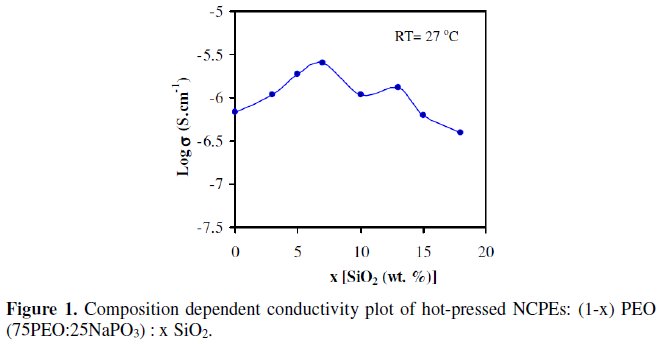
The NCPE films beyond 15 % filler SiO2 concentration were unstable and brittle. One can clearly note from the figure that the two conductivity maxima were obtained at 7 and 13 wt. (%) of SiO2, and then decreased on further addition of filler. A conductivity enhancement of more than one order of magnitude (σ ~ 2.5 x 10-6 S.cm-16) was achieved at room temperature for SPE host complexed with 7 wt% of nano-size filler SiO2. This NCPE film composition: 93 [75 PEO: 25 NaPO3] : 7 SiO2 has been referred to as Optimum Conducting Composition (OCC), as mentioned. The increase in conductivity is due to the increase in degree of amorphousity and/ or space charge double layer effect, which can be explained by the various models [13, 14]. Another possible mechanism for conductivity enhancement could be the creation of additional hopping sites and favorable conducting path ways for migrating ionic species through Lewis acid-base interactions between ionic species and O/ OH sites on the filler grain surface.
To characterize the ion conductance behavior in NCPEs, the ionic mobility (μ), mobile ion concentration (n) and ionic transference number (tion) were determined at room temperature employing a dc polarization TIC technique, as mentioned in Section 2. Fig. 2 shows 'log μ - x' and 'log n - x' plots for NCPEs films: (1-x) [75PEO: 25NaPO3]: x SiO2.
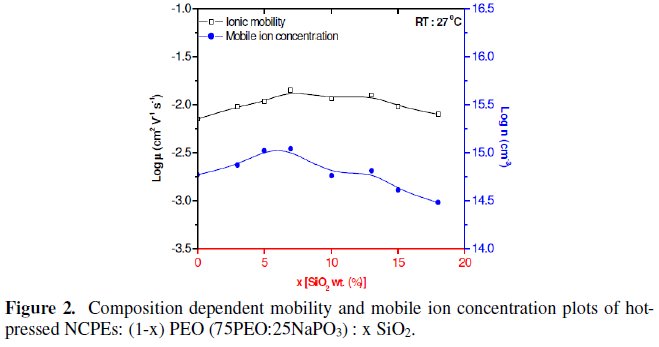
It is obvious from the figure that both the variations are almost analogous to 'log σ - x' and the highest values of 'μ' and 'n' at room temperature were obtained at x = 7 wt. (%). These results clearly indicated the fact that the increase in room temperature conductivity of OCC NCPE film is also due to the increase in 'μ' & 'n' both. The ionic transference number (tion) ~ 0.95, was obtained for OCC NCPE which is very close to unity.
This, in turn, indicated the fact that the hot-press synthesized NCPE is purely an ion conducting system with Na+ ions as the sole charge carriers. The increase in 'n' would be due to the availability of loosely entangled Na+ ions with the polymer chains, while increase in 'μ' would be a consequence of increased degree of amorphousity in SPE host. Table 1 lists the room temperature values of σ, μ, n & tion obtained for the solid polymer electrolyte (SPE) host and nanocomposite polymer electrolyte (NCPE) OCC films.

The magnitude of ionic transference number (tion ~ 0.95), obtained for both SPE host & NCPE OCC, revealed the fact that majority of available Na+ ions do take part in the conduction process.
Fig. 3 shows the XRD analysis of NCPE OCC: 93 [75PEO: 25NaPO3] : 7 SiO2 as well as SPE host: 75PEO: 25NaPO3 and pure PEO to confirmation of polymer-salt/ filler complexation.
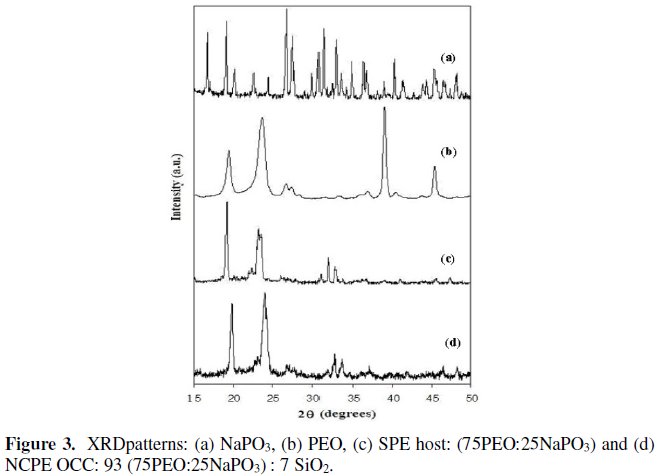
On a closer inspection, it can be clearly noted that some of the peaks of pure PEO became relatively broader as well as less- prominent/ feeble after salt complexation/ SiO2 dispersal. This is usually attributed to the increase in the degree of amorphousity and also confirmed the salt complexation as well as to some extent, dispersal of filler SiO2 in the SPE host.
The surface morphology of SPE host and NCPE OCC were observed by scanning electron micrograph (SEM), as shown in Fig. 4.
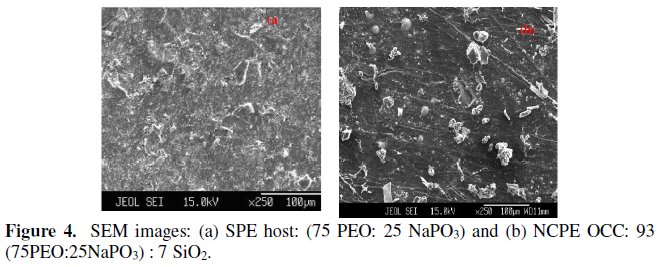
The smooth surface morphology of NCPE OCC is clearly indication of uniform distribution of SiO2 and reduction in the crystallinity of pure host after adding filler SiO2 at 7 wt.%.
Fig. 5 shows the DSC thermogrames for the pure PEO, SPE host and NCPE OCC. The broad endothermic peak was observed in polymeric films at ~ 65-70 °C and it is corresponding to the melting point temperature of pure PEO.
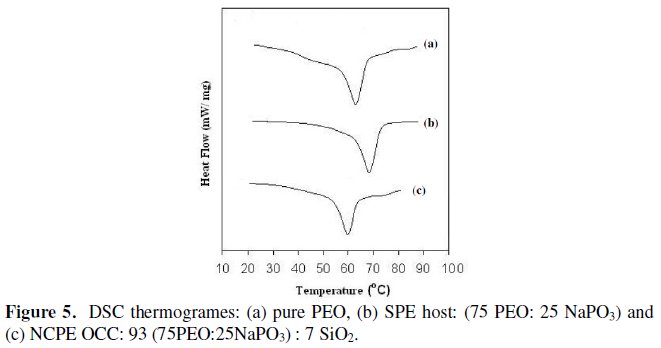
The slightly shifting in the melting point temperature towards higher side in SPE host is also indicative of the confirmation of polymer-salt complexation and the slightly shifting in the melting point towards lower side in NCPE OCC is due to the increase in the amorphousity, which is also indicative of the formation of NCPE membrane. A possible mechanism for this behavior could be the creation of additional hopping sites and favorable conducting pathways for ionic migration.
To evaluate the activation energy (Ea), the temperature dependent conductivity measurements were carried out in all the NCPEs: (1-x) [75PEO: 25NaPO3]: x SiO2. Fig. 6 shows 'log σ - 1/T' plots for the films of different filler concentrations (x).
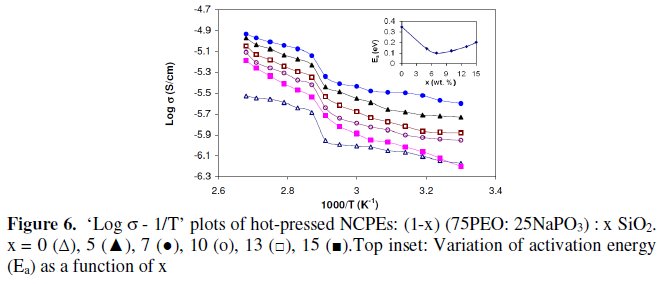
The increase in conductivity with temperature can be interpreted as a hopping mechanism between coordinating sites, local structural relaxation and segmental motions of the polymer electrolytes complexes [15]. All the plots exhibited thermally activated Arrhenius variations and can be expressed by following linear equation:

where Ea is the activation energy (in eV), involved in the thermally activated process. The activation energy (Ea) values, for all the compositions, were computed from linear least square fitting of the above equation and plotted as a function of x. 'Ea - x' plot is shown as top-inset in Fig. 6.
It can be clearly noticed that for NCPE OCC film, the activation energy Ea ~ 0.1 eV is lowest as compared to other films. Low 'Ea' is indicative of relatively easier ion migration in the newly synthesized hot-pressed NCPE material.
Fig. 7 shows the cell potential discharge profiles for polymeric cell under different loads viz. 100 kW, 50 kW at room temperature.
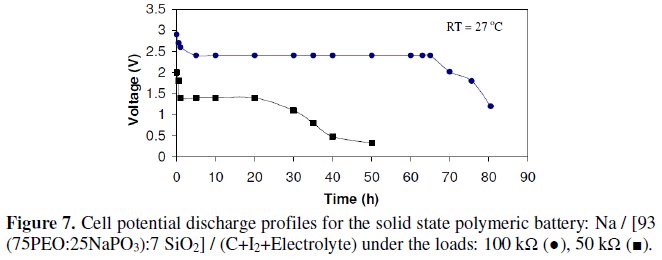
The Open Circuit Voltage (OCV) ~ 2.75 V was obtained for the cell. It can be clearly noticed that except for the initial potential drop, OCV value remained practically stable for ~ 75 h. when discharged through 100 kW (i.e. during a low current drain state). However, the cell potential decreased relatively faster when discharge through 50 kW load (i.e. during higher current drain states). Table 2 lists some important cell parameters for polymeric cell, calculated in the plateau regions of the discharge profiles.

On the basis of these studies, it can be inferred that the above cell, based on this newly synthesized Na+ ion conducting NCPE, performed fairly satisfactorily especially during low current drains. The ionic transference number (tion) for the newly synthesized NCPE OCC was also determined employing electrochemical cell potential method using the following equation:

where E' and E are the measured and theoretical values of OCV, respectively. On substituting E & E' values in the above equation, tion ~ 0.95 was observed for the NCPE electrolyte system which is exactly similar to what was obtained earlier using dc polarization method. tion ~ 0.95 is indicative of the fact that Na+ ions are the sole charge carriers in the solid electrolyte system with negligibly small electronic contribution to the total conductivity.
Conclusion
A hot-pressed Na+ ion conducting nano-composite polymer electrolyte (NCPE): [93 (75PEO: 25NaPO3): 7 SiO2] (wt. %) has been investigated. XRD, SEM and DSC studies have confirmed the polymer-salt complexation and formation of nano-composite polymer electrolyte. The ion conduction mechanism in NCPE has been explained on the basis of experimental studies on basic ion transport parameters viz. σ, μ, n, tion and Ea. Using the NCPE film, a solid-state polymeric battery has been fabricated and its discharge characteristics were studied under varying load conditions. The cell performed quit satisfactorily under low current drains.
References
1. G.B. Appetecchi, F. Croce, L. Persi et all, Electrochim. Acta 45 (2000) 1481.
2. B. Scrosati, F. Croce, L. Persi, J. Electrochem. Soc. 147 (2000) 1718. [ Links ]
3. G.B. Apptecchi, F. Alessandrini, R.G. Duan et all, J. Power Sources 1 (2001) 4335.
4. J.H. Ahn, G.X. Wang, H.U. Liu, S.X. Dou, J. Power Sources 422 (2003) 119. [ Links ]
5. C.W. Lin, C.L. Hung, M. Venkateswarlu, B.J. Hwang, J. Power Sources 146 (2005) 397. [ Links ]
6. A. Bhide, K. Hariharan, J. Power Sources 159 (2006) 1450. [ Links ]
7. G.B. Appetecchi, F. Croce, J. Hasson et all, J. Power Sources 114 (2003) 105.
8. R.C. Agrawal, A. Chandra, A. Bhatt, Y.K. Mahipal, New J. Physics 10 (2008) 043023. [ Links ]
9. A. Chandra, R.C. Agrawal, Y.K. Mahipal, J. Phys. D: Appl. Phys. 42 (2009) 135107. [ Links ]
10. A. Chandra, Eur. Phys. J. Appl. Phys. 50 (2010) 21103. [ Links ]
11. S. Chandra, S.K. Tolpadi, S.A. Hashmai, Materials Sci. and Engg. B 34 (1995) 18. [ Links ]
12. S. Chandra, S.K. Tolpadi, S.A. Hashmai, Solid State Ionics 28-30 (1988) 651. [ Links ]
13. A. Bunde, W. Dietrich, E. Roman, Phys. Rev. Lett. 55 (1985) 5. [ Links ]
14. N. Lakshmi, S. Chandra, J. Mat. Sci. 37 (2002) 249. [ Links ]
15. M. J. Reddy, T. Sreekanth, U.V.S. Rao, Solid State Ionics 126 (1999) 55. [ Links ]
Acknowledgement
The authors express their sincere thanks to DST, New Delhi for providing financial assistance through the 'Fast Track Young Scientist Research Project (No. SR/ FTP/ PS23/ 2009).
*Corresponding author. E-mail address: chandrassi@gmail.com
Received 6 February 2012; accepted 30 April 2012














